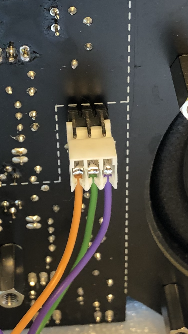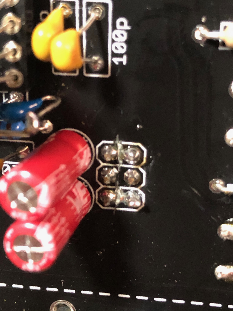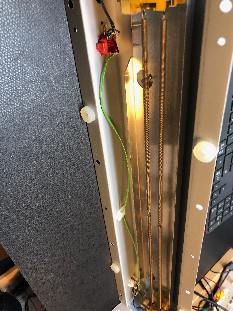This guide is for users with experience in SDIY, you need a scope and a frequency counter, DMM/DVM/LCR-Meter) i dont share infos about polarity of capacitors, this basics skills are required, otherwise feel free to ask me for a assembly service. (check the trusted builder list) please use a fume extractor. its needed to solder 6 SMT caps in 0805 format and 2 SMT power regulators. this guide is a best practice guide, i´m not responsible for failures/malfunctions/defects.
- lets start with the powersupply board - add all needed parts on the pcb, start with the two SMT power regulators.
there is one missing part (a dual choke) - please use wire links here or resistor legs
turn the 2 pol MTA header as described in the picture
if needed - wash the pcb carfully on the solderside
testing/trimming: use a 18-24V DC powersupply for input and set the output to 15V/-15V by usage of the both trimmers
measure between -V and 0 and +V and 0
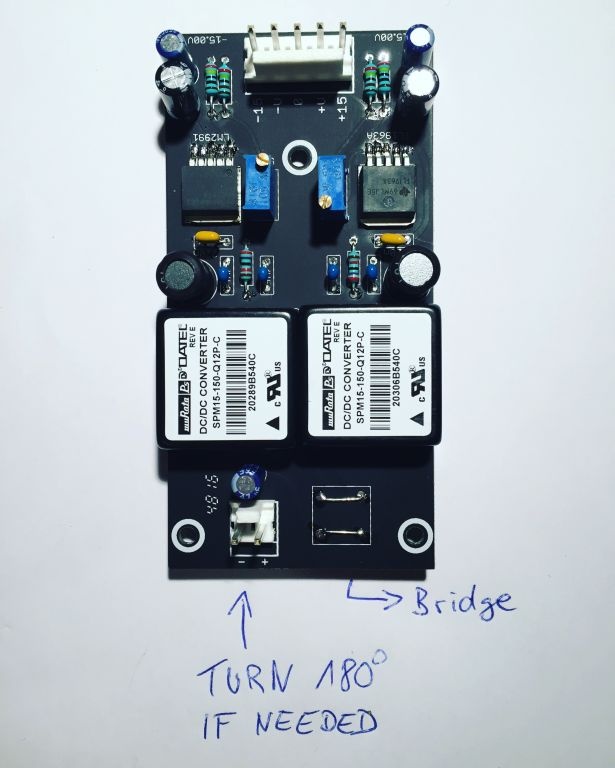
- Mainboard PCB - place all IC-Sockets ( tin one ic socket from top, place the ic socket and heat the ic socket pin - the socket drop in place
on the rear side of the PCB is for the LED driver a ic socket - we dont use this one - don't solder a ic-socket here ! see step14 - best practise - begin with the "most use values" and end with the value range Mainboard PCB - start with 100K resistors, 10K, 1K, 1M, 100R (reverb), 10R (Amp) 10M (top right)
if done - 47k, 4k7, 470K, 4M7, – 22K, 220K, 220R, 2M2, 33K, 3M3, 330K... — 30K1, 680R, 68K, 68K1, 680K... ..... and all other
please remember: on solderside are few resistors too - on VCO 4027 boards and filter boards too - its your choice to leave it for later or assembly it yet too (i prefer later) - Mainboard PCB - place all rectifiers 1N4148
- solder from top all parts
- cut the resistor and rectifier legs from bottom side
- place all MLCC caps and solder from top
- place all polyester/polypropylene caps - bend the legs from top
- add all transistors in place and solder one pin from top -(except the 2N3954, both 2N3958 - if you cant test this, use a milled IC-socket and cut the pins out - use this as socket)
- turn the pcb and solder all pins. (no switches, no fader, no jacks, no pot, no trimmers)
- you find on solderside few resistors - but take a look at step 14 - you don´t need the 3 resistors for the LED driver ( LEDs works too)
- wash the pcb 2-3 times if needed, i use Ispopropylen alcohole
- make a breaktime/pause yet - the pcb needs time to dry - if you don't need a break time/pause - assembly the filterboards and 3 VCO 4027 boards - wash the pcbs too, make sure you use flat 10uF electrolyte capacitors, use c0g, polypropylen or silvamica for the 680pF cap, don`t mount the connectionsheaders yet
- on the PCB solder side, there is ic socket for the LED driver (near the multiples) its needed to bridge with a resistor leg the middle pins
on TTSH V2 and V3, you can easily modify the LED system so as to trim the LEDs all the way of off. Replace the 3k3 resistor located next to the TL071 pads to a jumper. Tested.
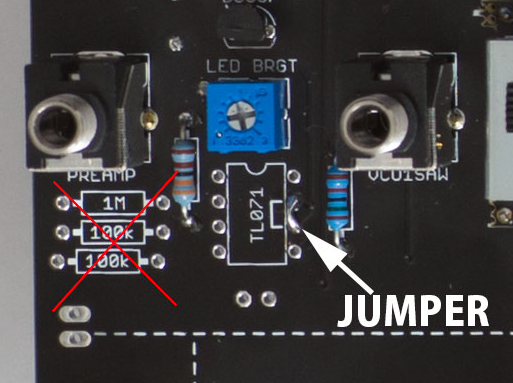 - Mainboard pcb: its time to add all other parts on the pcb - i prefer multiturn trimmers for the VCO V/oct trimmers 20K or 25K, but remember this can´t mounted on the frontpanel pcb side due to sizing, you have to open your TTSH for trimming the VCOs, begin with trimmers, faders - for faders keep attention on correct pcb side, best practice for faders: turn the pcb upwards on your desk add 4 faders in place, one hand holds the faders with other hand bend the faderpins with a flat screwdriver, solder all faders, add the Gain pot on top and solder them.
- add the header/sockets for VCOs, Filtercard - best practice: mount each header in socket - put them in place on the pcb - add the vco pcb on top and solder at first on top (sub vco pcb to header) not the header to mainboard pcb.
then start the soldertask for the other side. - check on your pcb other parts: you need to assembly few 2pol, 5pol MTA headers (gate/trigger/power) solder in the RCA jack for reverb (see known issues for wrong silkscreen), you have to add a 3 pol MTA header to powering the optional Gatebooster and/or TTSH sync board , on each section you find 6 pol holes.
- now its nearly done - doublecheck all solderpoints, missing resistors,caps..
- add the 13x 12mm spacers for speaker to pcb, dont fix it very strong - we need to align this in step 22
- you find on the pcb on left bottom near the speaker hole switch adapter pcbs, cut them out and place they behind the switches
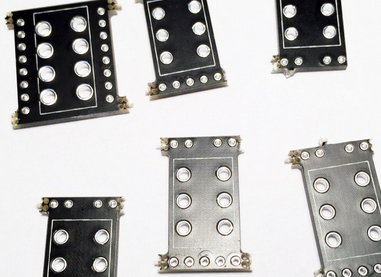 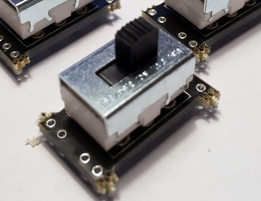 - setup all 81jacks in place, don`t solder the jacks yet
- place the frontpanel on the pcb/spacers - fix it with screws - if needed align the spacers
- add on each corner a washer and nut to a jack and at the bottom/near of the voltageprocessor
- at this time you need four hands if possible.. to turn the pcb without loosing jacks
- solder at first the jacks from step 21
- check the switch positions, align it and solder 1-2 pins (middle pins), check again the positions, if needed correct it.
- if the alignment of all parts are fine, solder all switches and jacks
- if needed clean with eartips and isopropylene the solderpoints of silder/switches/jacks
- add the 3 VCO 4027 modules and one filtercard in place.
- time for wiring: speaker wiring/headphone,
 - unmount the panel, add 3 long spacers (20-50mm to the 3 holes near voltage processor - the stands are used for the powersupply yet - mount the psu pcb on top), remount the panel
- wire the power-switch between + line and the powersupply pcb input
for power between power supply and mainboard - double-check the polarity, |





